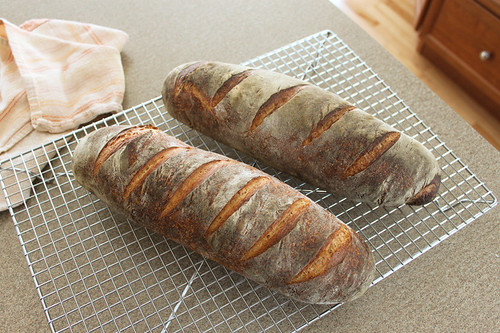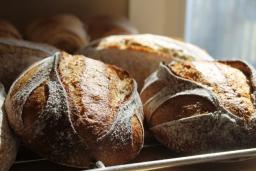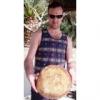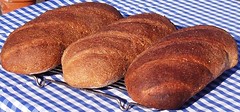Today's bread was a rustic sourdough using my wild yeast starter:

I was out of aged whole wheat, so used all white flour instead (the recipe usually calls for 13% whole wheat).
- 300 grams starter (100% hydration)
- 725 grams white flour
- 495 grams water
- 1 tsp malt powder
- 17 grams salt
Mixed all together with a 30 minute autolyse before adding the salt, then let it sit for 4 hours with one stretch and fold halfway. Made fairly freeform loaves, being careful not to de-gas the dough, and let them proof at room temperature (on parchment on the back of a cookie sheet) for 45 minutes while the oven preheated. I cover them with a smooth kitchen towel tucked around the well-floured loaves and put a paper towel roll between the loaves to keep them from spreading into each other. Very high tech!
After proofing I slashed them and baked them at 425F for 45 minutes, putting a cup of hot water into a hot cookie sheet in the oven at the same time to make steam. I think the slashes should have maybe been deeper. When the loaves sprung (?) up the oven they just sort of flattened. But other than that, I have no complaints.
I've made the rustic sourdough a few times since I developed the starter last fall and I am always amazed and thrilled when the loaves rise so beautifully in the oven, with no added commercial yeast. It's very magical. Also extremely chewy, sour and delicious!
It was dark by the time we sliced it for supper, but I managed to get an okay photo of the crumb:

And as a bonus, while the bread dough was sitting for most of the day in between stretch and folds, I used the rest of my starter to make sourdough english muffins using the recipe from Wild Yeast blog. This was my first time making english muffins, and I was really pleased.
My only modification was to use all white flour due the aforementioned whole wheat flour shortage in the house. The dough was very, very sticky and stayed that way, so I did add a little more flour as I mixed. I cut them out with a 3" crumpet ring, and proofed them on the back of a baking sheet, covered with plastic wrap. I baked them on my Oster griddle set to 275F, 8 minutes per side. The griddle is known to stay pretty cool, so I can't guarantee that the 275 setting is really 275, but whatever it was, it worked well.

They ended up looking pretty close to the storebought Costco ones my kids devour when they go to their grandparents, but taste so much better! And I recognize all the ingredients! I'll be doing this recipe again, with the whole wheat flour next time.





















